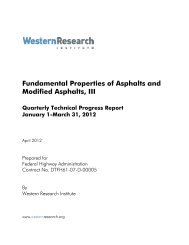Fundamental Properties of Asphalts and Modified Asphalts, III
Fundamental Properties of Asphalts and Modified Asphalts, III
Fundamental Properties of Asphalts and Modified Asphalts, III
You also want an ePaper? Increase the reach of your titles
YUMPU automatically turns print PDFs into web optimized ePapers that Google loves.
The increase in carbonyl at the center <strong>of</strong> LTA3 compared to the center <strong>of</strong> STA suggests<br />
significant aging occurred during the eight-day oven aging period. The apparent carbonyl<br />
gradient from the center to the edge in LTA3 suggest the oxidation reaction is diffusion<br />
controlled <strong>and</strong> that the core has increased anisotropy due to aging.<br />
Since the cores were prepared using AAD-1 asphalt, the observed differences in carbonyl content<br />
were further quantified by estimating G* as shown in figure 2-2.2.18. The asphalt at the center<br />
<strong>of</strong> STA had a G* <strong>of</strong> 10,600 Pa (at 60˚C <strong>and</strong> 10 radians/sec). The estimated G* at the center <strong>and</strong><br />
edge <strong>of</strong> LTA3 was 17,000 <strong>and</strong> 27,500 Pa, respectively. The complex shear modulus <strong>of</strong> AAD-1<br />
(at 60˚C <strong>and</strong> 10 radians/sec) after st<strong>and</strong>ard PAV aging (20 hours, 300 psi) was 14,700 Pa., which<br />
is somewhat less than the G* at the center <strong>of</strong> LTA3, suggesting the eight-day oven aging effect is<br />
more severe than the st<strong>and</strong>ard PAV test.<br />
Since differences in aging in the presence <strong>of</strong> aggregate at atmospheric pressure compared to<br />
aging without aggregate at high pressure are not well understood, these results must be<br />
considered preliminary. Some aggregates may have a catalytic effect on oxidation that is not<br />
currently accounted for in the st<strong>and</strong>ard PAV test.<br />
Log G* , Pa, 60C, 10 rad/sec<br />
6.00<br />
5.50<br />
5.00<br />
4.50<br />
4.00<br />
3.50<br />
2.75E+04 Pa<br />
1.70E+04 Pa<br />
1.06E+04 Pa<br />
37<br />
y = 6.92x + 1.74<br />
R 2 = 0.99<br />
Linear (PAV 60C<br />
<strong>and</strong> 80C points)<br />
3.00<br />
0.2 0.25 0.3 0.35 0.4 0.45 0.5 0.55 0.6<br />
Normalized Carbonyl (total peak ht) Absorbance<br />
Unaged<br />
RTFO<br />
PAV 100C<br />
PAV 60C<br />
PAV 80C<br />
STA center<br />
LTA3 center<br />
LTA3 edge<br />
Figure 2-2.2.18. Estimated G* <strong>of</strong> recovered asphalt from the center <strong>of</strong> STA <strong>and</strong> the center <strong>and</strong><br />
edge <strong>of</strong> LTA3. Correlation plot <strong>of</strong> G* versus carbonyl peak height is based on AAD-1 60˚C <strong>and</strong><br />
80˚C PAV’ed asphalt. Note: the infrared spectra were normalized to the umbrella bending b<strong>and</strong><br />
at 1376 cm -1 . Unaged, RTFO <strong>and</strong> PAV 100˚C points were not included in the linear regression.





